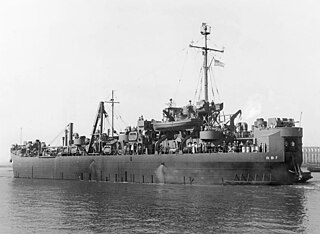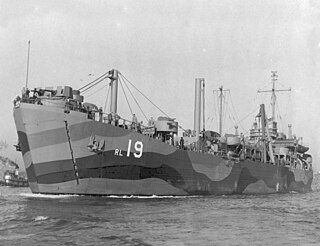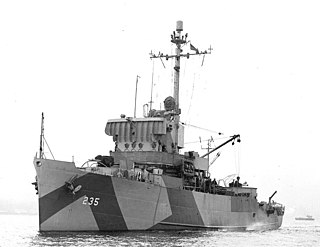Service history
Due to the cessation of hostilities, YDG-11 saw little or no active service before being berthed with the Pacific Reserve Fleet at San Diego, California. She was retained on an inactive, in service, status until the winter of 1946 and 1947, when she was placed out of service, in reserve. On 1 November 1947 she was re-designated ADG-11. The ship remained inactive until July 1951, when she was again placed in service. Assigned to the Far East, ADG-11 was based at Yokosuka, Japan until sometime in 1954. After that, her home port was Sasebo, Japan. On 1 February 1955, she was renamed Ampere. The ship was placed out of service in February 1957. Her equipment was transferred to USS Surfbird , a minesweeping vessel which was redesignated a degaussing ship on 15 June 1957. She remained in reserve in the Far East until the summer of 1961, when the decision was made to dispose of her. Her name was struck from the Naval Register on 1 July 1961, and she was sold on 21 June 1962, to the Philippine President Lines of Manila. Her final disposition is unknown.

USS Numitor (ARL-17) was to be laid down as an LST-542-class tank landing ship but was instead laid down as one of 39 Achelous-class repair ships landing craft repair ships built for the United States Navy during World War II. Named for Numitor, she was the only US Naval vessel to bear the name.

USS Surfbird (AM-383) was an Auk-class minesweeper built during World War II for the United States Navy. She was the only U.S. Navy ship named for the surfbird.
USS Armadillo (IX-111), the lead ship of her class of tanker was the only ship of the United States Navy to be named for the armadillo, an insect-eating mammal which has an armorlike shell encasing its back and head.
USS Execute (AM-232) was an Admirable-class minesweeper built for the United States Navy during World War II. She was originally ordered and laid down as USS PCE-905, the lead ship of the PCE-905 class of patrol craft. She was reclassified as an Admirable-class minesweeper by the time of her June 1944 launch, and named Execute by the time of her November 1944 commissioning. After service in the Pacific during World War II, she was decommissioned in August 1946 and placed in reserve. While she remained in reserve, Execute was reclassified as MSF-232 in February 1955 but never reactivated. In 1962, she was sold to the Mexican Navy and renamed ARM DM-03. In 1994, she was renamed ARM General Juan N. Méndez (C51). She was stricken in July 2001, but her ultimate fate is not reported in secondary sources.
USS Deperm (ADG-10) was a degaussing vessel of the United States Navy, named after the term deperm, a procedure for erasing the permanent magnetism from ships and submarines to camouflage them against magnetic detection vessels and enemy marine mines. Originally planned as a patrol craft escort (PCE-883), she was laid down in 1943, launched in 1944, and commissioned in 1945. She was subsequently redesignated a degaussing vessel, YDG-10, and named Deperm.
The third USS Magnet (ADG-9) was a degaussing vessel of the United States Navy, named after the magnet. Originally planned as a patrol craft escort (PCE-879), she was laid down on 27 May 1943 by the Albina Engine & Machine Works of Portland, Oregon; launched 30 September 1943; reclassified YDG-9 on 23 December 1943; and commissioned 10 July 1944.

USS Lodestone (ADG-8) was a degaussing vessel of the United States Navy, named after the mineral lodestone. Originally planned as a patrol craft escort (PCE-876), she was laid down on 27 May 1943 by the Albina Engine & Machine Works of Portland, Oregon; launched 30 September 1943; reclassified YDG-8 on 23 December 1943; and commissioned 10 July 1944.
USS Aristaeus (ARB-1) was planned as a United States Navy LST-1-class tank landing ship, but was redesignated as one of twelve Aristaeus-class battle damage repair ships built for the United States Navy during World War II. The lead ship in her class, she was named for Aristaeus, the only US Naval vessel to bear the name.

USS Sarpedon (ARB-7) was laid down as a United States Navy LST-542-class tank landing ship but was converted as one of twelve Aristaeus-class battle damage repair ships built for the Navy during World War II. Named for Sarpedon, and also she was the only US Naval vessel to bear the name.

USS Telamon (ARB-8) was planned as a United States Navy LST-542-class tank landing ship but was converted as one of twelve Aristaeus-class battle damage repair ships built for the Navy during World War II. Named for Telamon, she was the only US Naval vessel to bear the name.

USS Menelaus (ARL-13) was laid down as a United States Navy LST-542-class tank landing ship but converted to one of 39 Achelous-class repair ships that were used for repairing landing craft during World War II. Named for Menelaus, she was the only US Naval vessel to bear the name.

USS Sphinx (ARL-24) was laid down as a United States Navy LST-542-class tank landing ship but converted to one of 39 Achelous-class repair ships that were used for repairing landing craft during World War II. Named for the Sphinx, she was the only US Naval vessel to bear the name.

USS Patroclus (ARL-19) was laid down as a United States Navy LST-542-class tank landing ship but converted to one of 39 Achelous-class repair ships that were used for repairing landing craft during World War II. Named for Patroclus, she was the only US Naval vessel to bear the name.

USS Romulus (ARL-22) was laid down as a United States Navy LST-542-class tank landing ship but converted to one of 39 Achelous-class repair ships that were used for repairing landing craft during World War II. Named for Romulus, she was the only US Naval vessel to bear the name.
USS Facility (AM-233) was an Admirable-class minesweeper built for the United States Navy during World War II. The ship was ordered and laid down as PCE-905-class patrol craft USS PCE-906 but was renamed and reclassified before her June 1944 launch as Facility (AM-233). After earning three battle stars for service in the Pacific during World War II, she was decommissioned in September 1946 and placed in reserve. While in reserve, Facility was reclassified as MSF-233 in February 1955 but never reactivated. In October 1962, she was sold to the Mexican Navy and renamed ARM DM-04. Her ultimate fate is not reported in secondary sources; she may have been out of service by April 1973 when another member of the Admirable class was acquired by the Mexican Navy and given the name DM-04.

USS Maricopa County (LST-938) was an LST-542-class tank landing ship built for the United States Navy during World War II. Like many of her class, she was not named and is properly referred to by her hull designation. She was later named after Maricopa County, Arizona, she was the only US Naval vessel to bear the name.

USS Fixity (AM-235) was an Admirable-class minesweeper built for the United States Navy during World War II. The ship was ordered and laid down as PCE-905-class patrol craft USS PCE-908 but was renamed and reclassified before her December 1944 commissioning as Fixity (AM-235). She earned two battle stars in service in the Pacific during the war. She was decommissioned in November 1946 and placed in reserve. In January 1948, she was transferred to the United States Maritime Commission which sold her into merchant service in 1949. Operating as the Commercial Dixie, she sank in the Ohio River in the late 1990s.

USS Monmouth County (LST-1032) was an LST-542-class tank landing ship built for the United States Navy during World War II. Named after Monmouth County, New Jersey, she was the only U.S. Naval vessel to bear the name.
USS Wallacut (YTB-420), later YTM-420, was a tug that served in the United States Navy from 1945 to 1947 and from 1950 to 1976.
USS Thrasher (AMS/MSC-203) was a Bluebird-class minesweeper acquired by the US Navy for clearing coastal minefields.












